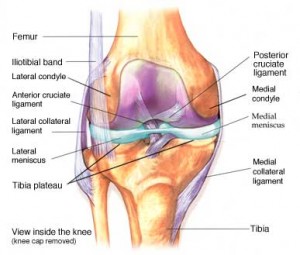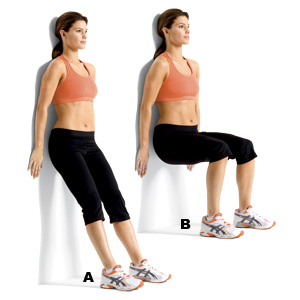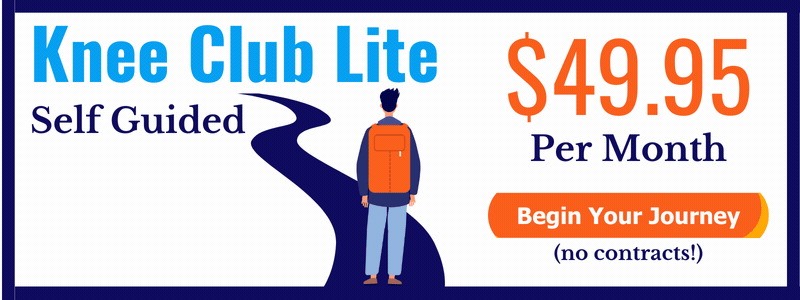I get lots of questions about knee pain and weak knees…
Reminds me of the old saying, “If I had a nickle for every time I heard about knee pain, I would be a millionaire.”
Anyhow, there is a huge demand to figure out how to bring support to the knee joint when it is experiencing knee pain. So many people look to knee braces to pick up the slack.
But first, let’s look at the knee joint to see what brings it strength and stability to begin with. The main components of the body that hold the knee joint together are the ligaments. By definition ligaments connect bone to bone. So at the very center of your knee are the 4 main ligaments that hold your knee together:
– ACL (Anterior Cruciate Ligament)
– PCL (Posterior Cruciate Ligament)
– LCL (Lateral Collateral Ligament)
– MCL (Medial Collateral Ligament)
It was explained to me by a Dr. friend of mine shortly after my knee surgery, Dr. Ralph Dobelbower,
“Dr. D” as we affectionately called him, explained to me that the ACL is about the thickness of a #2 pencil and pretty much holds the knee together. He added it is amazing how something so thin is able to handle all the pressure from the rest of the body it does and keep the knee together. 
Of course when any of these ligaments are torn it is nearly impossible to regain normal stability in the knee again without surgery. However, there are many instances when these ligaments are not torn and the knee is still unstable. As a result, many people look to knee braces to bring stability and support to the knee joint.
This is all well and good in theory however the reality of these braces doing the same job as the ligaments in the knee is something quite different…
There are both pros and cons with knee braces. All of these I experienced myself trying out different types of knee braces in an attempt to find out how to get my knee to feel normal again.
The pros being they definitely keep the knees warm when the seasonal temperature is cold and depending on some of the thicker neoprene style knee braces can keep the knees especially toasty on summer days. So much so that you will need a towel to keep up with the sweat produced. Depending on how snuggly the knee brace fits this can prevent swelling from occurring while the knee brace is on however after you take the knee brace off it is an incredible relief. There are also the bigger metal style braces like the one at the top of this post that keep the knee in a somewhat locked position preventing it from hyper extending or twisting.
Then there are the cons and one of the biggest cons to all of the knee braces has to be…I didn’t want to wear them! I didn’t want to deal with the hassle of remembering to bring them to workout, to deal with the smell because ALL of them smell no matter how much I tried to clean them, and then when I was working out. I was never totally confident that I wouldn’t re-injury my knee again. This all added up to trying to figure out what is the underlying cause of the knee instability to begin with.
Which takes us full circle back to the ligaments we talked about at the beginning of article. Strengthening the ligaments in the knees is key to making sure your knee joint has the strength, stability and support it needs so you never have to think about wearing a knee brace again.
Now the next question invariably presents itself, “But I heard that there is no way to strengthen the ligaments in my knee joint. My (fill in the blank) told me so.”
This has always led to more questions on my part, “How do they know?” “Has your (fill in the blank) ever had knee pain?” “Is the knee therapy that you have been doing working?” “If it has then why do you still have knee problems?” “What other options has your (fill in the blank) given you besides that ligaments can’t be strengthened?’
It bring to mind a quote by T. Harv Eker that goes, “It NOT what we know that’s the problem. It’s what we know THAT ISN’T SO, that’s the problem.”
Besides most of the time when you get close to strengthening the ligaments in your knee is when you quit the exercise.
Try this at home if you are able…
Find a sturdy wall and put your back up to it. Next squat down with your back pushed up against the wall so your knees are at a 90 degree angle. Now wait for 30 seconds…
Most likely before the second hand hit 30 your legs began to shake and you stopped doing the exercise. This is key to understanding how to strengthen ligaments in knee joint. Do as many google searches as you want, there is very little out there at this point teaching you how to strengthen the ligaments in your knees so you can rid of your knee braces.
The ligaments are the body’s natural knee braces, the only ones that are right for you all you need to do it strengthen them properly.


Marty
I’d check with your doctor and the manufacturer of the brace on whether the brace is providing stability or how tight the brace should be, or if it’s fitting properly.
I’m personally not a big fan of knee braces. I dislocated my knee several times wearing one and came to the conclusion that developing strong pain free knee joints is the key for everything you’re looking to the knee brace to do.
Bill
Like most, I still do not have a diagnosis of exactly what is wrong with my left knee. I am in PT, but one exercise of pulling my leg up from the floor with a strap as I sit on the edge of the chair and lean forward is a killer and no “gentle” way to do it without causing long term pain for the rest of the day. I am now using a brace on the left side and the pain is very manageable when I stand and walk, awkward as it is. I have two “bone on bone”… Read more »
2 questions…i originally hurt my left knee the first time when i was 22, now 47..i was running hard to catch a fly in left centre. i reached up to catch it, but the centre fielder dove and took out my left leg…in the hurdle stretch with my left leg(bad leg) bent the knee won’t go down to the ground no matter how hard i push it….this is the tension pattern in my left hip that you often talk about…could it be left over all these years? #2..i run a half marathon every oct…now that i am 47 it is… Read more »